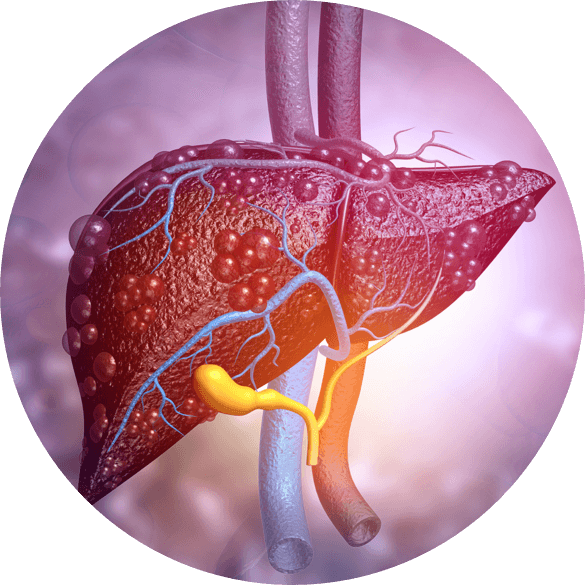Intended for licensed healthcare professionals located in the United Kingdom only.
▼ This medicinal product is subject to additional monitoring. This will allow quick identification of new safety information. Healthcare professionals are asked to report any suspected adverse reactions
This medicinal product has been authorised under a 'conditional approval' scheme
FGFR2 fusion testing


Molecular profiling for the treatment of cholangiocarcinoma
Genomic alterations such as chromosomal translocations and fusions contribute to malignant transformation.1
Genomic studies reveal that ~50% of patients with cholangiocarcinoma (CCA) have actionable alterations, including fibroblast growth factor receptor 2 (FGFR2) fusions or rearrangements.2
FGFR2 fusions/rearrangements are strong oncogenic drivers.3 FGFR2 fusions/rearrangements occur in 10–16% of intrahepatic cholangiocarcinoma (iCCA) cases.3
- FGFR2 fusions are detectable early in disease progression and are key drivers of tumour growth.4,5
- Molecular profiling is necessary to identify FGFR2 fusions and rearrangements.1,4,5
Methodologies to determine FGFR alterations
Genomic alterations with potential therapeutic implication are frequently found in patients with CCA,2 supporting the rationale for molecular profiling at diagnosis. A variety of molecular profiling methods are now available, with next-generation sequencing (NGS) and fluorescence in situ hybridisation (FISH) among the most common assays.2,6,7
NGS allows the opportunity to analyse a tissue sample for multiple alterations at the same time. Although the specimen size for NGS is initially larger and the turnaround time can be longer than for other methodologies, its more extensive coverage of genes of interest can be an advantage.8-10
FISH was originally designed to identify one specific, predetermined alteration at a time. Although multigene FISH assays can detect multiple prespecified genetic alterations, NGS may provide additional, non-prespecified information not possible to detect through FISH.6,7
FGFR2 fusions have a wide range of fusion partners.2 Therefore, to identify patients with FGFR2 fusions, it is important to select an assay that:
- Can detect FGFR2 fusions (which are distinct from FGFR2 point mutations).1,11,12
- Can detect all FGFR2 fusions, including those with known or unknown fusion partners (ie, FGFR2 fusion-partner agnostic).1,11,12
The European Society for Medical Oncology (ESMO) recommends parallel sequencing of several genes using focused NGS over single gene testing in patients with advanced disease.13

- Jain A, et al. JCO Precis Oncol. 2018;2:1–12.
- Lowery MA, et al. Clin Cancer Res. 2018;24:4154–61.
- PEMAZYRE® (pemigatinib). Summary of Product Characteristics.
- Arai Y, et al. Hepatology. 2014;59:1427–34.
- Borad MJ, et al. Curr Opin Gastroenterol. 2015;31:264–8.
- Dudley JC, et al. J Mol Diagn. 2016;18:124–30.
- Hu L, et al. Biomark Res. 2014;2:3.
- Cree IA, et al. J Clin Pathol. 2014;67:923–31.
- Damodaran S, et al. Am Soc Clin Oncol Educ Book. 2015;e175–82.
- Su D, et al. J Exp Clin Cancer Res. 2017;36:121.
- Silverman IM, et al. Cancer Discov. 2020;11:326–39.
- Barr FG. Expert Rev Mol Diagn. 2016;16:921–3.
- Vogel A, et al. Ann Oncol. 2023;34:127–40.
PEMAZYRE self-directed learning



